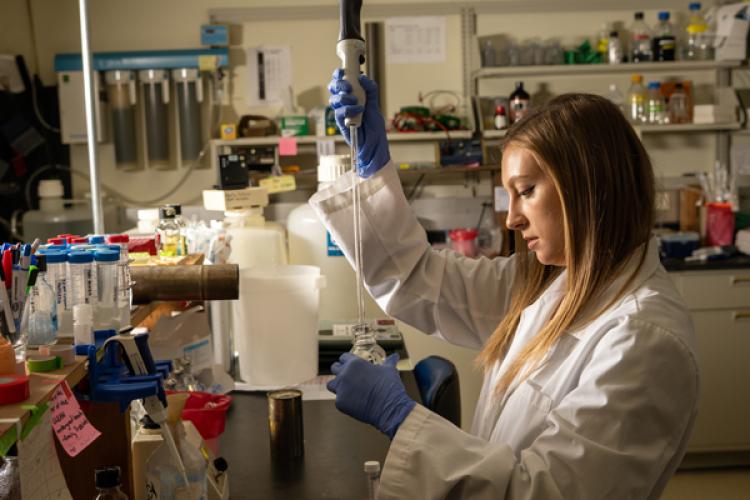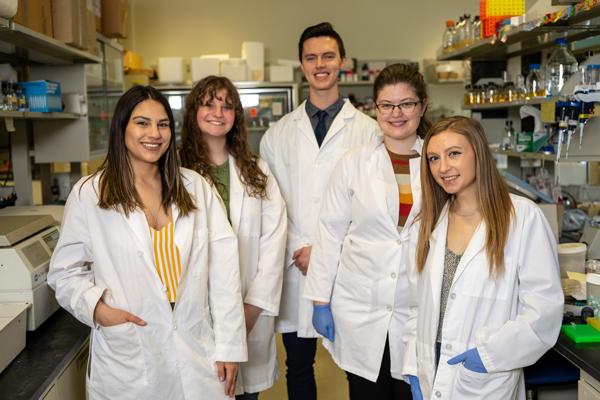
What Emily Marino didn't expect to find in the lab

Getting Ready for Expo
From Emily Marino's first day as a Bobcat, she knew she would be spending a lot of time in a lab, conducting experiments, and writing her Honors Tutorial College (HTC) senior thesis.
What she didn't know was that it would be so much fun, she would make great friends, and she would be presenting her work on the prevalent but potentially dangerous Staphylococcus aureus bacteria at Student Expo on April 7.
"It's been a long journey to this point for sure! This project is my HTC senior thesis, and ever since I joined the Carroll Lab my freshman year, I've tried to keep in mind that I would need to have a thesis project eventually. I set up a tutorial with Dr. Carroll my sophomore year to start nailing down an idea, and I've been interested in extracellular vesicles (EVs) produced by Staphylococcus aureus ever since," said Marino, an HTC Biological Sciences major with a minor in German. Ronan Carroll, Ph.D., is associate professor of biological sciences in the College of Arts and Sciences.
"My favorite part of doing research has been working with the other people in the Carroll Lab," Marino said. "They're an amazing group of people and make coming into work every day so fun. I think it's so important to be happy and having fun in the environment you work in. If you're not having a good time, your science is going to reflect that. Aside from that, I love being in a larger lab for the collaboration and exchange of ideas. My project wouldn't exist without Raeven Bastock and Paul Briaud combining ideas from their respective projects together, and I think some of the best science comes out of collaborations like that."
Marino added that when it comes to mentorship, giving is as important as receiving.
"The most fun part has been training some of our newer undergrads in the lab as they helped me finish up some of my experiments! I've been teaching Emily Sudnick and Riley Zielinski how to culture human cells and perform cell viability assays. They're so fun to work with, and I've loved getting a chance to mentor and teach others," she said.

The Mystery She Wanted to Solve
Bastock, a Molecular and Cellular Biology and Biological Sciences Ph.D. candidate in the Carroll Lab, has been working on projects investigating Staphylococcus aureus bacteria at two different physiologically relevant temperatures for the bacteria—37°C is core body temperature, and 34°C is the temperature of the anterior nares (of a person's nose), where approximately 30 percent of the population has harmless colonies of Staphylococcus aureus. Paul Briaud, a postdoc in the lab, took this idea a step further and decided to look at the differences in EVs produced by S. aureus at these two important temperatures.
"Paul got a really interesting result: the EVs produced at 34°C were more toxic to human macrophages, a type of immune cell, more than those produced at 37°C. This result is unexpected, as 34°C is normally thought of as the 'colonization' temperature, while 37°C is thought of more as the 'infection' temperature," Marino said.
"I wanted to try to solve the mystery of this interesting result, and I had already been building my skills taking care of our human macrophage cells for the lab, and thus my thesis project was born!" she said.
Extracellular vesicles (EVs) are nano-sized, spherical, bilayered membrane vesicles that contain proteins, polysaccharides, lipids, and, of importance to the Carroll group, nucleic acids.
"We hypothesize that the fusion of bacterial EVs, produced at different physiologically relevant temperatures, with host cells can deliver varying RNA molecules that influence host cell gene expression in different ways,” Marino said. “To test this hypothesis, THP-1-derived macrophages were exposed to EVs produced by Staphylococcus aureus grown at 37°C and 34°C. The effect of exposure to S. aureus EVs on macrophage gene expression was evaluated using RNA sequencing (RNA-seq) and compared to non-infected controls. Analyzing host cell response to EV34 and EV37 using RNA-seq allows us to examine on a global level how RNA introduced to human cells can influence gene expression."
Mentors and colleagues
"My main mentor is of course Dr. Carroll. I want to have my own lab someday, and I hope that I can be as great a mentor to my future students as he has been to our lab. He's always there when you need him and has been extremely encouraging throughout the entire duration of my project," Marino said.
"We have a lot of really fantastic people in our lab who tend to fall victim to imposter syndrome (myself included), and Dr. Carroll will believe in you even when you start doubting yourself."
Marino cites additional faculty members who have supported her throughout her research, including Soichi Tanda and Donald Holzschu in Biological Sciences in the College of Arts and Sciences; Erin Murphy in the Heritage College of Osteopathic Medicne; and Jennifer Hines in Chemistry and Biochemistry in the College of Arts and Sciences.
